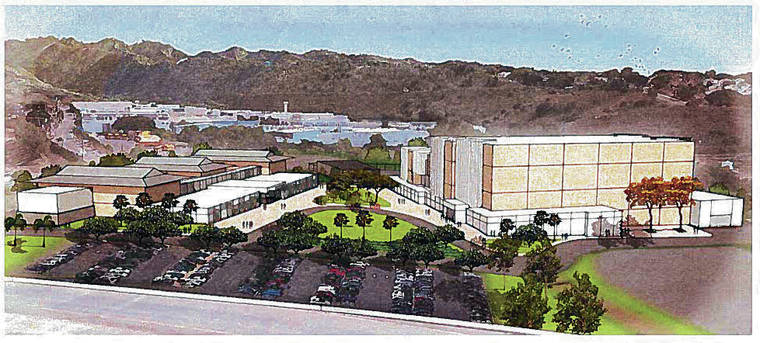A permit clearing the way for the relocation of the Oahu Community Correctional Center to Halawa from Kalihi won an 8-0 approval from the Honolulu City Council Wednesday, but the contentious project still needs funding from state lawmakers.
Council members previously Opens in a new tab had stalled any action on a Plan Review Use permit to the state Department of Accounting and General Services, suggesting it was premature given concerns raised by Halawa residents and the uncertainty over funding at the Legislature.
But modifications made to Resolution 19-136 Opens in a new tab have apparently made it more
acceptable for Council
members.
Among the most recent changes inserted by Council members Brandon Elefante and Ron Menor are requiring the state to obtain building permits for any major structures and then updating the project’s traffic plan whenever a building permit is approved and again six to nine months after the site is occupied.
Traffic has been a key issue for area residents worried about the impacts that a relocated prison will have when coupled with the New Aloha Stadium Entertainment District, Opens in a new tab also in its planning stage.
Menor, who heads the Council Zoning, Planning and Housing Committee, said after the meeting that the traffic mitigation plans will help address increased traffic expected during construction and when the jail is operational.
“The traffic mitigation measures could include adding buses and shuttles for visitors and setting aside an area in the facility where the courts can conduct hearings through video-conferencing to reduce inmate transports to the courts,” Menor said.
Additionally, the approval requires the state to submit, as part of an annual report to the city and community, “an update on the feasibility of establishing a treatment and counseling area within the OCCC to provide health services to homeless detainees who suffer from mental illness or substance abuse.”
The $525 million project is a priority for Gov. David Ige’s administration. The Department of Public Safety said the current location is overcrowded, obsolete and inefficient. Meanwhile, the governor is eyeing the Kalihi site, which is along the route of the city’s upcoming East Kapolei-to-Ala Moana rail line, as a potential development opportunity.
The permit allows the state to close the existing OCCC facility on Dillingham Boulevard and relocate it on 29 acres at what’s now the state Department of Agriculture’s Animal Quarantine Station. The site is about a mile away from the existing Halawa Correctional Facility.
The master plan calls for a four-story detention center, a two-story prerelease facility outside the new OCCC and a third building that would contain a warehouse, central energy plant and facility maintenance operations.
There would be approximately 1,044 beds, slightly more than OCCC’s current 982 beds. The existing Laumaka Work Furlough Center would remain in Kalihi.
Even project planners emphasized that Wednesday’s approval is an initial step in a lengthy process. Permit approval only “allows for further planning and community outreach.”
Joseph Earing, branch chief for DAGS Public Works Division, said the administration requested $20 million from the Legislature this session and is awaiting a decision.
In the meantime, his staff has some money available to do more preliminary planning work, Earing said.
If funding is received from the Legislature this year, the state will solicit proposals in hopes of securing a private partner for the facility, Earing said.
The Ige administration is hoping the facility will be completed by the end of 2025.
Councilwoman Carol Fukunaga, who represents Halawa, was out of the room when the vote was taken. Fukunaga said after the meeting that those living in the area still have concerns and are hoping to be able to provide their input at future planning phases.
The Aiea Neighborhood Board in November recommended approval of the permit.

